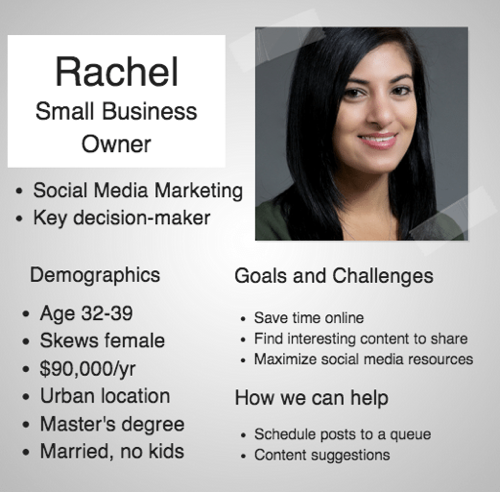You may be getting lots of readers on your blog, traffic on your site, fans and followers on your social media channels. But is your content reaching the right people?
You may be putting lots of time, care and effort into creating and sharing great content. But is it the right content for the people you’re looking to attract?
You can’t win with just one or the other. Why? Because your audience isn’t “everyone”. And your content, no matter how fantastic it is, will most likely go unnoticed by the people who just don’t care about your brand, cause or product.
And even if it does attract an audience, it won’t necessarily be the best audience for your brand, i.e. the people who will eventually want to buy your products and services.
Want to run a successful blog, non-profit or business? Then you need both.
You need to understand who are the people you want to reach and what they’re looking for and then create content that resonates with them.
In this post, we’ll explain why it’s so important to find your target audience and how to define it. We’ll also share some tips to help you create the right content that “sticks” for the right people.
Why defining your target audience is key to your business success
There are lots of small business owners that skip the target audience research part. Why? A limited marketing budget and lack of time are usually the reasons that are being invoked most often.
Sure, the process of defining your target audience is not as easy as creating an Instagram post. But it’s necessary if you want to make sure that whatever piece of content you share online – a social media post or story, an infographic, a video, a case study, a blog post – won’t go unnoticed by your target audience since it’s been created specifically for them and with them in mind.
When you create content for everyone, it may be in-depth and informative and high-quality, but it’s not dedicated to the people you want to attract to your place of business. So, while it may be useful for some people, it won’t be for the ones who end up buying your product or service.
What happens next? You might wrongly assume that content marketing doesn’t work or, worse, that your business idea isn’t good enough since you’re not making money out of it.
On the other hand, here’s what happens when make it a priority to define your target audience before writing a word:
- You know and understand who it is that might be interested in your product or service.
- You’re able to more easily choose topics and create effective content that speaks directly to those who are most likely to buy from you.
- You know what is the best way to reach them, meaning where they spend time online and what type of content they’d be most receptive to.
- You slowly yet steadily start to develop trust, authority and a long-term relationship with your prospects. How? By solving their actual problems through valuable content that resonates with them.
- You realise content marketing is cost-effective, helps you to stand out from the competition and turns prospects and visitors into customers when you take the time to do it right.
It’s true – defining your target audience takes time and effort but you’ll quickly realise it’s worth it. Once you understand who it is you’re trying to attract, you’ll find it much easier to create the right message and the right type of content that will connect with them.
How to define your audience and create targeted content
Follow these steps to define your target audience and start creating content that resonates with your prospects.
Step 1: Create a buyer persona
A buyer persona is a profile or a detailed description of your ideal customer that’s based on research. It includes information on everything from their gender, location, income, job title to their personality, needs, pain points and challenges. And this profile is put together in a way that makes it look like it’s a real person.
Here’s an example:


So, a buyer persona allows you to get a clear picture of what your ideal customer is like, including their goals, challenges and common objections to products and services, as well as other unique attributes.
You can learn more about how to create your buyer persona from our post.
Step 2: Dig deeper
To create content that engages and resonates strongly with your audience, you also need to better understand their problems, concerns and what they find entertaining.
This means that at a minimum you’ll need to find answers to these questions:
- What problems is your target audience facing?
- How can you help solve their problems?
- How did they find your business?
- Where do they spend most of their time online?
Also try to find out what they’re struggling with. For example:
- What do they want to do better?
- What motivates them to be better?
- What keeps them awake at night?
If you’re struggling for answers, there are lots of ways to find out more about your target audience including:
- Via email. Send an annual audience survey. For example, blogger Michael Hyatt conducts a survey of his blog readers to learn more about who they are, and what they want to read on his blog.
- Via social media. Interact with your audience on social media to learn more about what they want and need. Join or create relevant groups on different social networks like Facebook and LinkedIn and see what they’re talking about that’s relevant to your business and industry. Create polls and surveys to ask your fans and followers what they’re interested in.
- Review customer support emails and chats to find out what they’ve complained or had trouble with in the past.
- Look through blog comments and discussion forums related to your business.
- Read reviews and testimonials from previous customers where they describe their experience with your business.
- Use analytics tools like Google Analytics and/or Facebook Insights to find out more about your audience and what they’re searching for online.
Step 3: Create targeted content that connects with your audience
Now that you’ve gathered all this knowledge and information, it’s time to use it to create content that resonates with your audience.
Here are a few tips to consider:
Understand the difference between what you do and sell, and what you need to talk about
If you want your audience to find your content useful, you need to make sure that every piece of content you put out there is about them and what they care about, and not about you or your product.
In other words, even when you’re talking about your business, products or services, you need to focus more on the benefits and less on the features. Why? Because people don’t buy features. They buy into the idea that a product or service will make their life better, and it’s your job to tell them how yours will do just that.
Address their pain points and needs
Whenever you create a new piece of content, whether it’s a blog post or a podcast, you need to make sure that it’s addressing a specific problem, pain point or topic of interest for your audience. If it doesn’t, then why should they bother reading it?
Consider the buyer journey
Your prospects will have different questions depending on where they are in the buyer journey. Some may not know how you are so they may be wondering what you’re selling or whether you’re trustworthy or a legit business. Others may be ready to buy from you but are looking for reassurance that your products or services can help solve their problem.
No everyone who visits your site or blog is ready to buy. So make sure you consider how your topics and content connect to the buyer journey.
Wrapping up
It doesn’t matter how amazing your content is if it fails to engage your target audience. And most often the reason that happens is because that content doesn’t resonate with the people you want to reach.
The solution is simple: do your research first to find out who your prospects are and then create content that connects with them. It takes time to get it right but it’ll be worth it.
